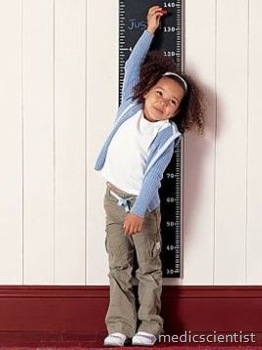Article Contents ::
- 1 DISORDERS OF GROWTH AND DEVELOPMENT
- 2 Growth GHD Causes may be :
- 3 Growth Classic Stage Theories
- 4 Growth GHD CLINICAL PRESENTATION —
- 5 Physical Exam Growth GHD
- 6 •Children with GHD:
- 7 •Adults:
- 8 Associated Conditions
- 9 Treatment
- 10 Growth GHD Adult GH deficiency
- 11 Growth GHD Treatment ,
- 12 Acromegaly
- 13 Growth and Development Disorders Diagnosis
- 14 Differential Diagnosis
- 15 Lab diagnosis:
- 16 Treatment
DISORDERS OF GROWTH AND DEVELOPMENT
Growth is dependent on GH, IGF, sex steroids, thyroid hormones, paracrine growth factors and cytokines. Growth also requires caloric energy, amino acids, vitamins and trace metals. Short stature results due to intrinsic and extrinsic factors which impair growth.
Growth GHD Causes may be :
- Most common cause of GHD in children is idiopathic.
- Most common cause of GHD in adults is a pituitary adenoma or treatment of the adenoma with surgery or radiotherapy:
- · Hormonal disorders
- · Systemic disorders
- · Genetic disorders
- · Hereditary disorders
- GH deficiency causes short stature, increased fat, high pitched voice, hypoglycemia, micropenis.
Growth Classic Stage Theories
| INFANCY (0–1 YR) | TODDLERHOOD (2–3 YR) | PRESCHOOL (3–6 YR) | SCHOOL AGE (6–12 YR) | ADOLESCENCE (12–20 YR) | |
| Freud: psychosexual | Oral | Anal | Phallic/oedipal | Latency | Genital |
| Erikson:psychosocial | Basic trust vs mistrust | Autonomy vs shameand doubt | Initiative vs guilt | Industry vs inferiority | Identity vs role diffusion |
| Piaget:cognitive | Sensorimotor | Sensorimotor | Preoperational | Concrete operations | Formal operations |
| Kohlberg:moral | — | Preconventional:avoid punishment/obtain rewards (stages 1 and 2) | Conventional:conformity (stage 3) | Conventional:law and order (stage 4) | Postconventional:moral principles |
Growth GHD CLINICAL PRESENTATION —
- GHD can be divided into congenital and acquired forms.
- A variety of congenital genetic causes of GHD:
- GH secretagogue receptor gene defects
- GH gene defects
- Transcription factor defects (PIT-1, PROP-1, LHX3/4, HESX-1, and PITX-2)
- GHRH receptor gene defects
- GH receptor/postreceptor defects
- Prader-Willi syndrome
- The single most important clinical manifestation of GHD of all causes is growth failure, and careful documentation of growth rate is critical to making the correct diagnosis.
Physical Exam Growth GHD
-
•Children with GHD:
- Most common presentation is short stature
- Assess pubertal status using Tanner staging system.
- Severe GHD children have maxillary hypoplasia and forehead prominence; kewpie doll appearance.
- Accurately measure height and weight.
- Newborns may present with hypoglycemia, jaundice, or micropenis.
-
•Adults:
- Decreased lean body mass
- Poor bone density
Associated Conditions
- Macroadenoma
- Sarcoidosis
- Sheehan syndrome
Treatment
- is replacement with GH 0.05 mg/kg/day subcutaneously for growth of 10 cm/year.
Growth GHD Adult GH deficiency
- is caused by hypothalamic or pituitary damage of area secreting GH. Later there may be FSH / ~H, TSH and ACTH deficiency also.
- There is lean body with fat abdomen, and increased waist size, hyperlipidemia, hypertension,’ left ventricular dysfunction.
Growth GHD Treatment ,
- Replacement of GH 1.25 mg/day. Women require higher levels then men.
- Liquid solutions for SC injection: These are available in multidose pen devices.
- Encapsulated GH in glycolide microspheres for deep SC administration.
- Either 1.5 mg/kg body weight once a month or 0.75 mg/kg twice a month.
- Daily therapy is more effective than 3-times-a-week therapy. The recommended dose is 0.04 mg/kg/d for children
Acromegaly
- This is due to increased secretion of growth hormone due to pituitary adenoma, extrapituitary tumors, hypothalamic tumors, pancreatic islet cell tumor, adrenal and thyroid tumors, pheochromocytoma.
- It is diagnosed at the age of 10 years or more. There is frontal bossing (prominent forehead), increased hand and foot size, wide thick jaw, space between incisor teeth, thick heal pads, coarse facial features, large nose, muscle weakness, oily skin, cardiomegaly, thick tongue etc. Patient looks abnormally huge.
- There is premature coronary heart disease, cardiomyopathy, arrhythmias and death. These patients have obstructive sleep apnea, diabetes mellitus, colonic malignancy.
Growth and Development Disorders Diagnosis
Differential Diagnosis
- Down syndrome
- Idiopathic short stature
- Noonan syndrome
- Prader-Willi syndrome
- Renal failure
- Russell- Silver syndrome
- Small size for gestational age in newborns
- Turner syndrome
Lab diagnosis:
- IGF-I (insulin-like growth factor) level is elevated.
- There is failure of GH suppression in response to glucose load (75 g glucose).
- Thyroid-stimulating hormone (TSH) (hypothyroidism should be excluded as a cause)
- Serum electrolytes (low bicarbonate levels may indicate renal tubular acidosis)
- IGF-1, IGFBP-3
- Multiple GH levels
Treatment
- Surgical resection (transsphenoidal) Somatostatin analogues-Octreotide acetate
- Bromocriptine, a dopamine agonist may suppress GH
- Irradiation
- Stereotactic ablation by gamma knife.


